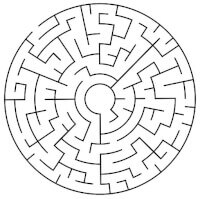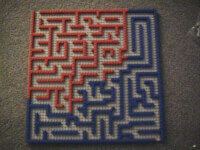Although both maze and labyrinth depict a complex and confusing series of pathways, the two are different. A maze is a complex, branching (multicursal) puzzle that includes choices of path and direction, while a labyrinth is unicursal, i.e., has only a single, non-branching path, which leads to the center.
Comparison chart
| | Labyrinth | Maze |
|---|---|---|
| Meaning | A labyrinth is a maze that has a single through-route with twists and turns but without branches. | A maze is a confusing pathway that has many branches, choices of path and dead-ends. |
| Level of difficulty | A labyrinth is not designed to be difficult to navigate. It may be long but there is only one path (unicursal). | A maze is a tour puzzle and can be designed with various levels of difficulty and complexity. |
| Entry and exit | A labyrinth has only one entrance and that is also the exit. There is just one path from the entrance to the center. | A maze may have different entry and exit points. |
| Significance | Some labyrinths have a spiritual significance. They signify the complex and long path to reach God. | Mazes are used in science experiments to study spatial awareness and (sometimes) intelligence. |
Difficulty
A labyrinth may be complex but is not difficult to navigate because it has a single unambiguous route to the center and back. Mazes can be constructed with varying levels of difficulty and complexity.
Here's an example of a labyrinth:
And here are some examples of a maze:
Entry and Exit
A labyrinth typically has only one entrance and the objective is to get to the center and then return. On the other hand, a maze may have an entrance and an exit with a complex path between the two.
History
Labyrinth is a word of pre-Greek ("Pelasgian") origin absorbed by Classical Greek. It is also related to Lydian labrys which means double-edged axe and ‘inthos’ means place.
- Coins from Knossos dated 3rd centure BC depict labyrinth symbols.
- Greek mythology - King Minos of Crete constructed the Labyrinth with the help of a craftsman Daedalus. Within it was the half-bull, half-human offspring of Minos' wife Pasiphae called Minotaur. In fact Daedalus and his son Icarus had difficulty getting out of it.
- Another legend states that the Cretan labyrinth had been a dancing-ground and was made for Ariadne, Minos' daughter. When Theseus, the son of Aegeus, King of Athens went inside the labyrinth to kill the Minotaur, Ariadne gave him a ball of string. Theseus used it and came out safely. This was mentioned by Homer in the Iliad xviii.590–593.
- Pliny's Natural History mentions four ancient labyrinths: the Cretan labyrinth, an "Egyptian labyrinth", a "Lemnian labyrinth" and an "Italian labyrinth". Herodotus, in Book II of his Histories, describes a "labyrinth" as a building complex in Egypt. Pliny mentioned the legendary Smilis as Lemnian labyrinth however Andrew Stewart regards it as a Samian temple's location en limnais, 'in the marsh'". Pliny also regarded the tomb of the great Etruscan general Lars Porsena as an Italian labyrinth, containing an underground maze but it seems as if he himself had not seen the labyrinth.
The word maze does not have much of a history. There was no distinction between the usage of the word maze and labyrinth. It was a place where you could wander in confusion or get lost. In modern times there are different types of maze:
- Logic mazes have rules for going in various directions.
- Mazes in three or more dimensions e.g. maze of bridges or natural caves.
- Picture maze forms a picture when solved.
- Ball-in-a-maze puzzles involve navigating a ball through a maze or labyrinth.
- Dead end maze is a maze game where the route creates the dead ends.
- Turf mazes and Mizmazes is a pattern like a long rope folded up, without any junctions or crossings.
- Loops and Traps Maze is a maze that features one-way doors. The opening doors may create dead ends and loops and lead you back to the starting point instead of the end point.
In 1970 there was craze for maze; it was equally famous among children and adults. Vladimir Koziakin, Rick and Glory Brightfield, Dave Phillips, Larry Evans, and Greg Bright were famous for their puzzle books. In later years people became more and more innovative with their drawings of mazes. Larry Evans and Bernard Meyers made mazes on 3-D structures.
Significance
A labyrinth was considered a trap for mean spirits. In some places it is depicted as a path for ritual dances. In medieval times it took a more spiritual notion of the hard path to god, traversing the path of a labyrinth was thought of as going on a pilgrimage. Later on the religious connotation was lost and it took the form of entertainment. Recently there has been resurgence in its spiritual aspect and people get into meditative mood while going through a labyrinth.
Mazes test the navigation and directional capabilities of individuals. They are used to study spatial navigation and learning abilities of individuals. A number of books have been published with several maze and maze puzzles.
Maze vs Labyrinth Video
This video explains the difference between a maze and a labyrinth.




 Polyglot
Polyglot  Linguist
Linguist  Greek Gods
Greek Gods  Difference between envy and jealousy
Difference between envy and jealousy Poseidon
Poseidon
Comments: Labyrinth vs Maze